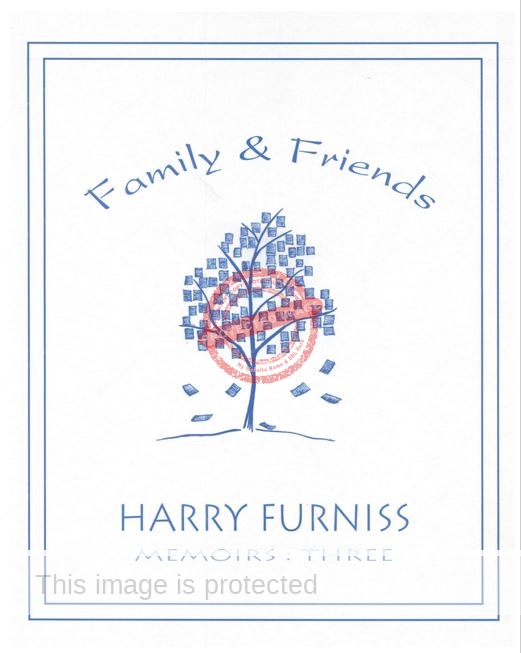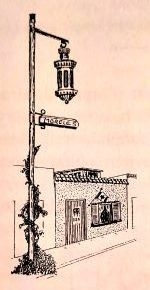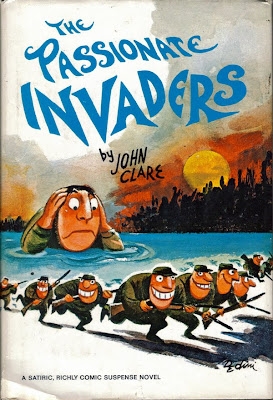Among the many Canadian visitors to Lake Chapala in the 1970s were Harry Furniss and his second wife, Enid. Late in life, Harry, the grandson of English artist and cartoonist Harry Furniss (1854-1925), wrote a three volume memoir, full of off-beat memories and humor, interspersed with small line drawings. It includes a chapter about visiting long-time friends Leslie and Eleanor Powell in Chapala, who first settled there in 1973.
Harry and Enid Furniss

Raised in Montreal, Harry Furniss (1920-2015) wrote radio dramas in his spare time, and served in the Royal Canadian Air Force (RCAF) during World War 2 (when he was captured by the Germans), before being appointed Director of Public Relations (RCAF) Overseas, in London, U.K. He married his RCAF-Womens Division aide, Enid, in London, in 1947. Enid (1911-2016), of English, Spanish and French heritage, had driven ambulances in London during the blitz.
After they settled in Canada, Harry spent a decade as a journalist for the Toronto Telegram, Reuters news agency, and The Vancouver Province, and then established his own corporate public relations consultancy. After decades of building and cruising pleasure boats on the rugged coast of British Columbia, Harry and Enid lived their final years in Victoria on Vancouver Island. Married for 68 years, Harry died there on 26 November 2015, at the age of 95, and Enid the following year on 27 December 2016.
The third volume of Harry’s memoir, Family & Friends, includes a chapter about visiting friends, Leslie and Eleanore Powell, who had settled in Chapala some years earlier.
Leslie and Eleanore Powell
U.K.-born Leslie Cooke Powell (1908-1999) was working at the Montreal Gazette when the second world war erupted. He joined the RCAF public relations department during the war, and served in North Africa, Italy and Northwest Europe, before being appointed Director of RCAF Public Relations (Overseas), based in London, England, where—in 1946, a year after the war ended—he married Canadian journalist Eleanore Roberta Martin.
Back in Canada after leaving the armed services, Powell worked as the Montreal Gazette’s aviation and military editor, before starting his own public relations company. He subsequently became the national PR director of the Canadian Red Cross Society, and of Canadair.
Eleanore Powell was a reporter for the Ottawa Citizen during the Second World War. After joining the women’s division of the Royal Canadian Air Force, she worked as a public relations officer in Ottawa, Newfoundland, and later for the RCAF Overseas headquarters in London, England. In 1999, following her death, her estate established the Robert and Alyce Martin journalism scholarships (named after her parents) for students entering the Master of Journalism program at Carleton University in Ottawa.
What was Chapala like in the 1970s?
The Powells’ first visit to Chapala was in 1973, and they subsequently visited the lake many times (and had a house there) in many of the next 17 years. Chapter 4 of Furniss’s book includes excerpts from letters he and Enid had received from the Powells describing their time at Chapala.

Sketch by Furniss
On their first trip, in 1973, the Powells drove down and stopped for a couple of nights at the Rincón del Montero hotel in Parras de la Fuente en route to to Mexico City. A week later, they drove west along Highway 15 to Morelia and then branched off along the southern shore of Lake Chapala to Jocotepec, where they stayed at La Quinta, then run by Bob Whipple: “It took us nine hours to drive from Mexico City to our ultimate destination, Jocotepec. An excellent road, much of it toll, with beautiful scenery.”
They stayed in a two room unit at La Quinta, which cost, for two, including three meals a day, $310 Cdn a month, plus 10% for service. After two weeks, the Powells “chanced upon an idyllic little house nearby at Chapala” and signed a one-year lease. Needing help with the Spanish in the lease, they were referred to a fellow Canadian (Bill Strange) who lived nearby. He wasn’t home, so Powell asked an English-speaking lawyer to check the contract. The lawyer refused any payment when he learned that the two men shared a mutual friend: “my old hometown pal and once-Mayor of Montreal, Pax Plante, who now lives in retirement nearby!”
Pacifique Plante
French Canadian lawyer Pacifique “Pax” Plante (1907-1976) became known as “the “Elliot Ness” of Montreal, after fighting city crime in the 1940s and 1950s and organizing the prosecution of many notorious gangsters and mafia members. Plante retired to Mexico in 1958 and lived there to his death in 1976. Understandably paranoid about the need for privacy and security, Plante built his retirement home high on the hillside east of Jocotepec. It had a commanding view over the only access route which winds up from the highway, and was designed to be mistaken from a distance for a chapel, not a private dwelling.
In one of those strange coincidences in life, Bill Strange turned out to be Captain William Strange, who had been Director Public Relations (Navy) Overseas when Powell held the equivalent position in the RCAF. Strange, and his wife, architect Jean Strange, had retired to Chapala in 1965, and the coincidences did not end there. Powell later learned that Strange had married his WREN assistant, just as he had married his RCAF-WD aide.
Once they had their casa (rent $64.00, all prices in Canadian dollars), the Powells were able to slash their living expenses. Return trips to Guadalajara on the air-conditioned coach were $1.45 for two. Pork was $1.80 a kilo, a pint of strawberries 40 cents, a cleaning lady charged 40 cents (then five pesos) an hour. For relaxation, the waters at San Juan Cosalá beckoned for $1.28 a day. They estimated that two people could easily live in Chapala at that time on $200.00 a month.
When the Funisses visited the Powells in 1975, they discovered that other mutual friends—John and Lenore Clare—were already occupying the Powells’ guest quarters, so they took a room at the Hotel Nido for $6.80 a night for two, including dinner.
John and Lenore Clare
 John Purvis Clare (1910-1991), who studied at the University of Saskatchewan, served as a public relations officer for the Royal Canadian Air Force in North Africa. During his lengthy journalistic career, Clare worked for The Saskatoon Star Phoenix, The Globe and Mail, The Toronto Telegram, and was the war correspondent for the Toronto Daily Star, as well as managing editor of MacLean’s Magazine and an editor at Chatelaine and Geos. His short stories were published in The Saturday Evening Post, Collier’s and many other magazines. He also wrote The Passionate Invaders, a humorous novel, published in 1965, about ‘the first armed invasion of the United States from Canada in more than a hundred years.’
John Purvis Clare (1910-1991), who studied at the University of Saskatchewan, served as a public relations officer for the Royal Canadian Air Force in North Africa. During his lengthy journalistic career, Clare worked for The Saskatoon Star Phoenix, The Globe and Mail, The Toronto Telegram, and was the war correspondent for the Toronto Daily Star, as well as managing editor of MacLean’s Magazine and an editor at Chatelaine and Geos. His short stories were published in The Saturday Evening Post, Collier’s and many other magazines. He also wrote The Passionate Invaders, a humorous novel, published in 1965, about ‘the first armed invasion of the United States from Canada in more than a hundred years.’
Lenore Reinke Clare (1907-1991) worked for the T. Eaton Company before accepting a position with RCA Victor, with involvement in all phases of casting, writing, producing and recording. She then built and managed a recording studio for Harry E Foster, and continued to work there through the war. She married John Clare in 1945, joined the CBC in 1957 and was a supervising script editor at CBC, in charge of the script department, from 1959 to 1972. Her wide-ranging interests helped take CBC’s radio plays to a whole new level.
After a few days catching up with their friends, the Furnisses then took a self-contained casita in a U-shaped motel in Ajijic, which cost $160 a month. They stayed for a month or so, exploring Ajijic and its environs.
Later letters to the Furnisses from the Powells include references to a “bang up July 1 (Canada Day) party at the Chula Vista Motel” given by Hector Márquez (who owned the main farmacia in Chapala), a paragraph musing on the possibility of becoming the Honorary Canadian consul in Chapala, and delight following the 1976 devaluation of the peso that everything was now even cheaper than previously. In 1977, the Powells rented a different house for the winter for $75 a month.
The Powells returned to Chapala in 1984, after a gap of four or five years, and rented a two-bedroom casa with huge garden for $160 a month. The following year, they rented a place for the winter in Guadalajara. Their last trip to Mexico was over the winter of 1989-90.
Sources
- Harry Furniss. 2003. Family and Friends, A memoir, vol 3. Canada: Trafford Publishing.
- The Times Colonist (Victoria, BC): 5 Dec 2015; 13 Jan 2017.
- North Bay Nugget: 28 May 1991, 12.
- Telegraph Journal: 19 Dec 1949, 3.
- The Toronto Star. 1991. Clare, Eleanor (Reinke). (obit). The Toronto Star, 29 July 1991, 50.
- Le Devoir: 11 August 1976, 6.
Comments, corrections and additional material are welcome, whether via comments or email.
Tony Burton’s books include “Lake Chapala: A Postcard History” (2022), “Foreign Footprints in Ajijic” (2022), “If Walls Could Talk: Chapala’s historic buildings and their former occupants” (2020), (available in translation as “Si Las Paredes Hablaran”), “Mexican Kaleidoscope” (2016), and “Lake Chapala Through the Ages” (2008).
Ah–this well written, chock full of info hit me in a different way. Although I never stayed in Chapala but I’ve visited many times. I’d probably have stayed a while had I known some of the wonderful people you bring to life in these articles. I see I am getting older than I want to acknowledge when I see this article and realize I visited Chapala before many of the people in this summary. Wow– how’s that age sneak up on me?
Thanks, Bill – you and me both!